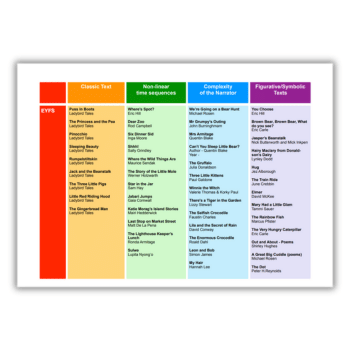Reading spine for EYFS-Y6, plus sample reading lesson Powerpoints
Early Years, KS1, KS2
Years R-6
Pie Corbett shares his expert advice on how to create a reading spine…
What is a reading spine?
A reading spine is a mapped-out book curriculum that provides the basic entitlement to experience great literature.
Every year of my teaching career, I would spend time deciding which books I would read to my new class. I published my first suggested reading spine about 25 years ago.
Over time, your school’s reading spine will shift and change in the light of new books and authors. However, the central core is a child’s entitlement to experience great literature, ensuring diversity and quality. This should cover literature in its broadest sense (novels and picture books, non-fiction and poetry).
How many books should be on your reading spine?
For Key Stage 2, I selected six core novels a year, plus one picture book. I chose that number because it leaves space for new publications, novel enthusiasms and books that speak to the moment.
The idea is for schools to choose a core that ensures every child’s entitlement to the best books available. However, it is important to leave some leeway and space in the programme. Certainly, one picture book a year is not sufficient at Key Stage 2.
For EYFS and Key Stage 1, I selected 12 core picture books a year plus some suggested early ‘chapter books’. You should increase this number considerably by carefully selecting ‘essential reads’.
Poetry and non-fiction
Once the basic reading spine is in place, the next step is to develop a poetry spine. You can build this around simple ideas such as a different anthology per term alongside a different poet per term.
Finally, schools can begin to think about which non-fiction texts they want every pupil to experience.
Why use a reading spine?
Great books begin to build frames of reference that children can use when meeting a new text. For instance, once a child has spent time with Anthony Browne’s Voices in the Park – for example, working for a week or so considering the four characters’ viewpoints – the book becomes a frame of reference for exploration of other narratives.
This enables pupils to discuss how we can see texts from the author’s viewpoint, the narrator’s and different characters’, as well as how different readers might view a text.
Questions to ask when creating a reading spine
When I created the first Pie Corbett reading spine for a school, I spent six weeks of the summer holidays with piles of books on the sitting room floor.
At first, there were too many in each year group. I found that setting myself a target of only six novels or 12 picture books a year forced me to make choices. Every book had to justify its place, so I asked myself the following questions:
- First of all, is each title an outstanding book that every child should experience?
- Have you tried and tested each book in the classroom, and is it a story that children still love? (Many of the so-called ancient classics such as Treasure Island bit the dust at this point.)
- Am I selecting a range of quality authors, avoiding over-emphasis on any single writer?
- Am I including books written in a range of writing styles about different themes?
- Are there links across the years so that children revisit core literary themes?
- Have I ensured diversity of authors, writing from a range of cultures about varying experiences of life?
I strongly suggest you discuss these questions and criteria with colleagues, and develop a reading spine for your own school.
Once you’ve agreed on your reading spine, resource the core texts with at least a half-class set of each book. Given limited budgets, this may take several years to work towards, but the aim is that children can at least share a book.
Making your reading spine impactful
The impact of your reading spine will hinge on whether you read to children daily. It’s essential that you get a school-wide strategy in place to ensure this happens.
EYFS and KS1
During the EYFS and Key Stage 1, this can take place at various times of the day to build the amount of reading that children experience.
These reading sessions are not the time to stop and ask questions. Rather, they are a time for children to simply experience the pleasure of a great read.
It is worth remembering that pausing to quiz the children associates reading with being asked questions, interrupts the flow of a story, and may mean that it is harder for a child to tie the scenes together and comprehend.
KS2
At Key Stage 2, teachers should devote a core time in the day for reading aloud to the class. Try and ensure that you do this throughout the year. It shouldn’t get lost amongst the myriad of other pressing demands.
Many teachers blend books together, so that a challenging picture book might run alongside a poem that illuminates the same experience or theme.
Daily read-aloud sessions are where children experience books that they could not read to themselves. In these sessions, give pupils access to high quality and challenging books that they would otherwise not experience.
Keep other books by the core authors, or on similar themes, in the school library. Introduce these through weekly ‘recommendation sessions’. Give children space for their own ‘recommended book’ displays.
Find Pie Corbett’s Reading Spine and Page Turners at shop.scholastic.co.uk/piecorbett
Example reading spine
This reading spine from Layton Primary School uses four text types. In his book Reading Reconsidered, Doug Lemov says that children should have access to five types of text in order to read with confidence.
These are complex beyond a lexical level and demand more from the reader than other types of books. To fit the school’s context and pupils’ needs, staff adapted his suggestions, enabling them to include a more diverse range of text types.
- Classic text
This involves texts that are over 50 years old and feature vocabulary and syntax that is vastly different and typically more complex than texts written today. - Non-linear time sequences
In these books, time doesn’t unfold consistently. It may move in fits and starts or double back. These books need careful introduction and may need to be read more than once. - Narratively complex
These books may feature unreliable narrators, multiple narrators or non-human narrators. They may also feature multiple plot lines. - Impressionist
Poetry often features in this category. Pupils need to assemble meaning via nuances, hints, uncertainties and clues.
Teachers choose a text from the reading spine, which is a working document, and read this book every day for 15 minutes, always making sure to finish the book.
On Monday and Friday, the text is studied through a quick quiz, recap questions and VIPERS questions.
Reading spine download
This download contains:
- Example reading spine for EYFS-Year 6
- Example reading lesson plan PowerPoints on the following topics: Queen Victoria (Y2); the Stone Age (Y3); Roman Empire expansion (Y4); science (Y5); WW2 (Y6)
Claire Jones is now headteacher at Eccleston Primary School in Chorley. Follow her on Twitter at @clairejones_ht. Visit her blog at clairejonesteacher.wordpress.com. Read more about how Layton Primary developed a consistent whole-school approach to reading that will prepare pupils for university.














